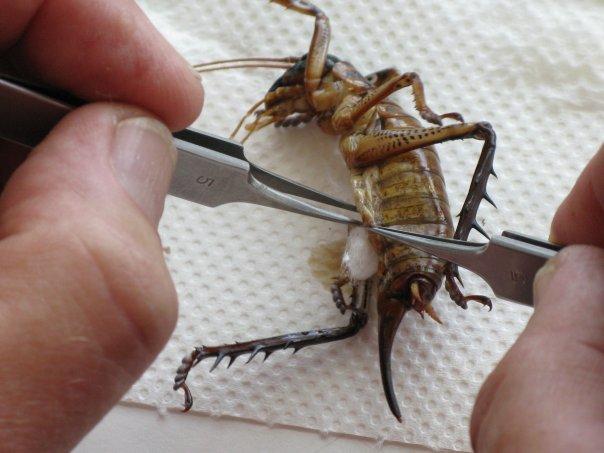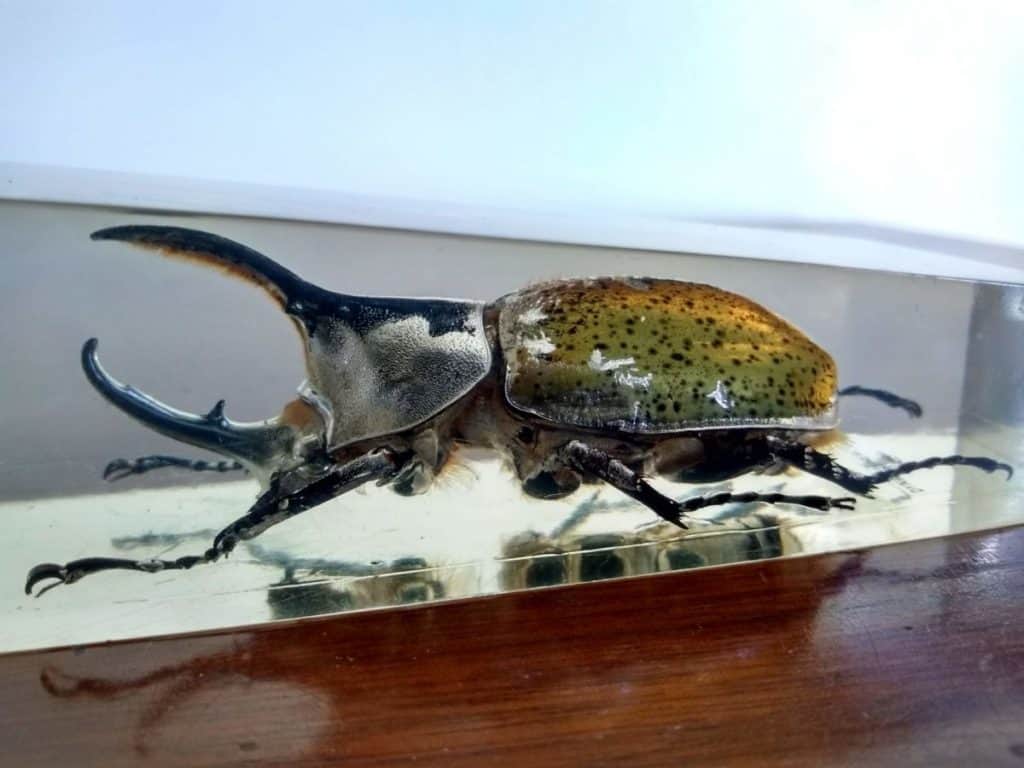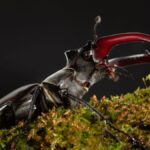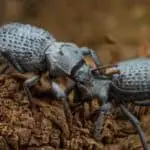I am sorry for your loss. While you can bury or cremate your deceased insect pets, the good news is you can also preserve them easily. Here 3 common methods used by entomologists to preserve dead insect that we can follow.
Dry Preservation
Dry preservation is where you preserve dead insect in dry condition. It is suitable for larger or hard-bodied insects such as butterflies or beetles. You will need some patience in setting your insects though.
Cut a lateral opening on the abdomen of your insect and remove everything from the abdomen. Stuff the abdomen with cotton wool. Soften the insect in a moist chamber. Hold the insect in place and carefully arrange its antennae, wings and legs using a forceps into the desired posture. Fix the positioning of legs and wings with multiple pins. Air-dry your insect. Remove unnecessary pins and frame the insect.
Depending on what type of insects you are preserving, there are different things to consider. Continue reading to learn more.
Preparing Your Insect
The purpose of emptying the abdomen of your dead insect is to reduce rotting. You should do this if you are preserving an insect with a large abdomen, such as larger beetles and roaches.
For those with smaller abdomen (eg. butterfly, dragonfly), you can either inject 40% formalin or 95% alcohol into their abdomen, or do nothing. Note that injecting formalin or alcohol may cause some discoloration.
Dead insects lose moisture quickly, and can be very difficult to handle as it hardens. You can soften the insects by putting it in a moist jar or chamber.
First you need to boil some water. Sterilize your chamber with hot water and lay a few layers of paper towels at the bottom of the chamber. Wet the paper towels with the boiled water and a few drops of disinfectant such as Dettol or Lysol to prevent growth of mold.
Place your dead insect into the chamber and cover the chamber with a lid. Leave it in the chamber for 2-3 days. After that, try if you are now able to manipulate the insect. If you can’t, leave it for more days.
If you are handling beetles, you can soak the beetle in warm water for 10-30 minutes, until you can easily manipulate its legs.
Certain insects such as butterflies have colorful scales on their bodies. Do not touch them with your hands. Otherwise, you may rub off the scales.
Mounting and Keeping Your insect

Now that your insect is softened, you can start manipulating its posture. Gently manipulate the insect (either using pins or forceps) into the posture you want after pinning (or not pinning) them, and use more pins to fix the posture.
Tiny insects are harder to manipulate but it can be done using very fine needles. For butterflies, you need to pin it onto a foam through the thorax for manipulation; for mantis, roaches and large beetles, I prefer not to pin them since they are large enough for me to handle without pinning.
The toughest part is to spread the wings because they are so fragile! Unless you are confident, or the wings are the major highlight of that insect (eg. a butterfly), you can skip the wings.
To spread the wings for bigger insects, you need 3 pieces of foam (or a spreading board for butterflies). Place your insect onto 1 foam. Put 1 foam on the left and 1 on the right of your insect. The foams beside the insect should be as high as the height of your insect’s wings.
If you are dealing with butterflies, spread until the bottom of the front wings are directly perpendicular to the body so that both pairs of wings are fully visible. Otherwise, there will be overlapping of wings which covers the patterns.
After spreading the wings, keep the wings flat by securing them with paper strips pinned/taped over the side foams. If you are dealing with large beetles, you can pin through their wings using fine needles, directly under the 1st vein. You can also put their wings in between paper strips. Secure the wings with some paper clips to prevent curling, and then pin the wings onto the elevated foams.
Air-dry your insect for 1-4 weeks depending on the size of your insects. You can put your insect under a light bulb to accelerate drying. After that you can frame your insect and keep it somewhere safe.
Consideration for Dry Preservation
Dry preservation can be used for almost all adult insects: roaches, beetles, mantis, butterflies, bugs, crickets, large ants, wasps, bees etc. It allows you to fix your insects into any possible postures you like.
It comes with some disadvantages though: smaller species are difficult to manipulate, and the dried insects are brittle. They can easily fall apart due to vibration as they age.
Wet Preservation
Wet preservation is the simplest preservation method for insects. It is more suitable for soft-bodied insects that have no colorful scales on its body. Do note that wet preservation causes discoloration of your insect.
Cook your insect for 10 seconds to 2 minutes in boiling water depending on its size. Remove the insect and place it in 30% ethanol for 1 day. Transfer the insect into a 50% ethanol for another day, followed by 75% ethanol for yet another day. After that, place the insect into a permanent vial with 75% ethanol. Label the vial and keep your insect somewhere safe.
If done correctly, your insect can be preserved almost indefinitely in ethanol. Continue reading for more information.
Preparation for Wet Preservation
Like all living creatures, the insects have protein in their body. Cooking the insect in boiling water “fix” or denature the protein and kill the bacteria, which prevents your insect from turning black.
You can adjust the boiling time depending on the size of your insect. For instance, you should boil a large beetle grub for 2 minutes, but 10 second is sufficient for an ant.
I use ethanol (also known as ethyl alcohol) for wet preservation. If you can’t get your hands on that, the alternative is isopropanol or isopropyl alcohol. It doesn’t matter if your alcohol is denatured or undenatured.
You should not preserve your insect directly in 75% alcohol. Sudden exposure to high alcohol concentration will lead to rapid water loss which in turn shrivels your insect (unless your insect is very small, making it unnoticeable). The recommended way is to soak your insect in Kahle’s solution for around a week before transferring it to 75% alcohol. Kahle’s solution is basically a mixture of 95% ethanol, formalin, glacial acetic acid, and water in an 88:3:1:16 ratio.
I don’t use Kahle’s solution though, because it is hard to get one. To make your own Kahle’s solution you need to buy different chemicals, which I think is rather troublesome. As a workaround, I put my insect in 30% alcohol first, and slowly increase the concentration up till 75%.
Dilute your alcohol (usually bought in 95%-99%) with cooled boiled water to achieve the desired concentration. For instance, to make 10 oz of 30% alcohol, pour 3 oz stock alcohol into a container and top up with water until the final volume is 10 oz. You do not need to be extremely accurate in your measurement.
I personally use the serial dilution method in preparation of alcohol. This is where you prepare an alcohol solution of desired concentration, and use that resulting solution to prepare the next solution, and so on. I think it is more convenient, but probably it is just my habit. Here is the dilution that I’d use if I need 10 oz of alcohol for preservation:
| Stock alcohol concentration | 95% | ~75% | ~50% |
| Alcohol volume | 24 oz | 14 oz | 6 oz |
| Water volume | Top up till 30 oz | Top up till 20 oz | Top up till 10 oz |
| Resulting concentration | ~75% alcohol | ~50% alcohol | ~30% alcohol |
Keeping and Maintaining Wet-Preserved insect
After soaking your insect in 75% alcohol for a day, you can transfer your insect to a labeled vial containing 75% alcohol. This is because after 24 hours, the water from the body of your insect would have diffused out and diluted the alcohol in the vial.
Your insect should be kept in a vial with a tight cap. Keeping the vials in a fridge allows you to preserve your insect over a very long time. If you don’t want to keep it in a fridge, you should at least keep it somewhere cool, away from direct sunlight.
As the color of the insect bleeds over time, change the alcohol.
Consideration for Wet Preservation
Not all insects can be wet-preserved. Some of the insect pets that you can wet-preserve are eggs, beetle grubs, caterpillars, ants, wasps, flies, and all sorts of tiny insects. While certain tiny insects can be dry-mounted (eg. ants), I usually wet-preserve them because I don’t have the patience to mount them. They are too tiny for my clumsy fingers.
Although wet preservation can keep your insect for almost indefinitely, your insect will inevitably discolor to a certain extent over time.
While there are more advanced techniques such as slides mount for even smaller insects (eg. booklice, thrips), I have never kept those as pets, so I am not covering it here.
Be careful when handling alcohol as it is flammable and it can penetrate your skin quite fast. Always read the label for safety precautions and do not drink the alcohol!!
Resin Preservation

Resin preservation is where you immerse your insects into resin. It allows you to manipulate your insect into your desired posture much like the dry preservation method. At the same time it allows you to preserve your insect for a very long time, much like the wet preservation method.
To preserve your insect in resin, empty the abdomen of the insect and stuff it with cotton. Soften the insect and manipulate it into desired posture. Make sure the insect is completely air-dried. Mix casting resin according to the manufacturer’s instruction and immerse your insect in resin. Let the resin dry and that’s it.
Preparation of Insect
While the resin protects your dead insect externally, your insect may still be damaged from rotting. To prevent this, you should remove everything in the abdomen of your dead insect and stuff it with cotton. If your insect is small, you can inject 40% formalin or 95% ethanol into the abdomen instead.
Soften your insect and manipulate it into the desired posture like how you would do that in dry preservation. It is important to completely dry your insect before immersing it in resin so that it doesn’t rot from within.
Preparation of Resin
Mix your casting resin in accordance with the manufacturer’s instructions. Otherwise, your resin may not cure properly. When mixing, stir the mixture gently to avoid formation of bubbles. Stir until the resin and the curing agent are evenly mixed.
The label should tell you how much working time you have upon mixing the resin. You need to cast the resin within the stipulated time. Otherwise, curing kicks in and it will be very difficult to use your resin.
Casting Resin
You need a container as a mold for the resin. You can use a disposable plastic container, ice cube mold or silicon mold. A silicon mold is preferred because you can bend it to easily remove the cured resin later on. Do not use glass or metal mold because it will be difficult to remove the resin.
For bigger insects such as large beetles and hissing roaches, create a base layer by gently pouring a layer of resin into the mold, around 1/10 the height of your final product. Watch out for bubbles and remove them if possible. Cover the mold with a paper or lid to let the resin cure.
Put the insect into the same mold and cast a second layer of resin. This layer should not be too thick. The purpose of this layer is to secure the positioning of the insect. Cover the mold and let the resin cure.
Continue adding resin into the mold until the whole insect is covered. Depending on the size of your insect, you may want to do it in 1 go or split it into a few layers.
For smaller insects such as ants, wasps or crickets, you can pour the resin into the mold up to 50% of the height, and put the insect into the resin before it is cured. Hold the insect in position using a stick so that it doesn’t drift around. Once the position of the insect is stabilized, add more resin to cover the whole insect.
Leave the casted resin fully cured before you remove it from the container. Curing time differs depending on the product you use.
After the resin is fully cured, you can then remove it from the container and frame it. Sometimes the resin gets stuck in the container. You can use a hard needle to separate the resin from the walls of the container to remove the resin.
Recommended Supplies
Here’s our recommended supplies for insect preservation. Note that I get a small commission when you buy the items through the links in this page. This helps me to maintain the site without incurring additional costs to you.
Final Words
Each of the preservation methods has its pros and cons in terms of cost, difficulties and suitability. There is no right or wrong. For instance, I keep my queen ant ethanol instead of dry-mounting her. Use a method that suits your purpose and budget.
Whichever chemicals or reagents you use in preserving your insect, always read and follow the manufacturer’s instructions.
Note that this guide is for insect keepers who lose their pets and want to preserve them. If you want to preserve insects as specimens for professional purposes (museum, research etc.), you will need to look for a more specific guide.


